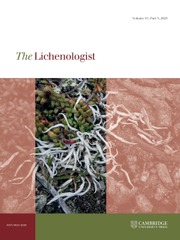Article contents
Photobiont associations in co-occurring umbilicate lichens with contrasting modes of reproduction in coastal Norway
Published online by Cambridge University Press: 27 September 2016
Abstract
The identity and phylogenetic placement of photobionts associated with two lichen-forming fungi, Umbilicaria spodochroa and Lasallia pustulata were examined. These lichens commonly grow together in high abundance on coastal cliffs in Norway, Sweden and Finland. The mycobiont of U. spodochroa reproduces sexually through ascospores, and must find a suitable algal partner in the environment to re-establish the lichen symbiosis. Lasallia pustulata reproduces mainly vegetatively using symbiotic propagules (isidia) containing both symbiotic partners (photobiont and mycobiont). Based on DNA sequences of the internal transcribed spacer region (ITS) we detected seven haplotypes of the green-algal genus Trebouxia in 19 pairs of adjacent thalli of U. spodochroa and L. pustulata from five coastal localities in Norway. As expected, U. spodochroa associated with a higher diversity of photobionts (seven haplotypes) than the mostly asexually reproducing L. pustulata (four haplotypes). The latter was associated with the same haplotype in 15 of the 19 thalli sampled. Nine of the lichen pairs examined share the same algal haplotype, supporting the hypothesis that the mycobiont of U. spodochroa might associate with the photobiont ‘pirated’ from the abundant isidia produced by L. pustulata that are often scattered on the cliff surfaces. Up to six haplotypes of Trebouxia were found within a single sampling site, indicating a low level of specificity of both mycobionts for their algal partner. Most photobiont strains associated with species of Umbilicaria and Lasallia, including samples from this study, represent phylogenetically closely related taxa of Trebouxia grouped within a small number of main clades (Trebouxia sp., T. simplex/T. jamesii, and T. incrustata+T. gigantea). Three of the photobiont haplotypes were found only in U. spodochroa thalli.
Keywords
- Type
- Articles
- Information
- Copyright
- © British Lichen Society, 2016
References
- 11
- Cited by




